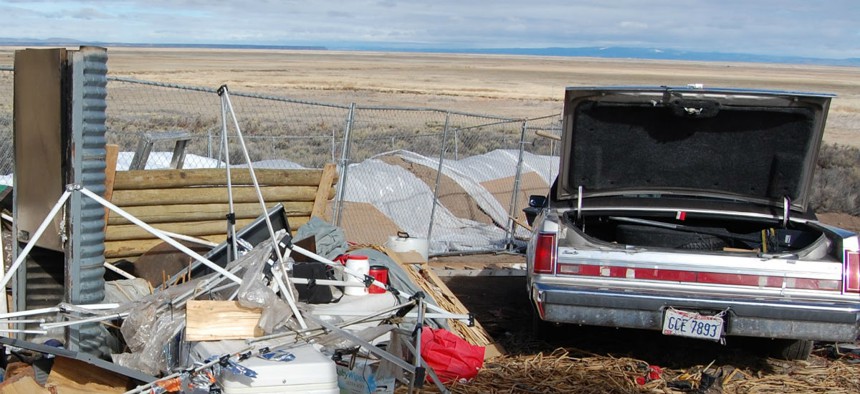Wildlife Agency Paid a Steep Price for Armed Occupation: $6.3 Million
Ten months later, two facilities remain closed.
This story has been updated with comment from Fish and Wildlife Service Director Dan Ashe, following a jury's acquittal of the defendants.
“I would describe it as completely trashed.”
That was how Linda Beck, a fish biologist at the Malheur National Wildlife Refuge, characterized in federal court last month the state of her office at the refuge following a five-week armed occupation by an anti-government militia in January.
Twenty-six defendants faced federal conspiracy charges in the U.S. District Court for Oregon.
Late Thursday, a jury acquitted seven defendants on federal conspiracy and weapons charges. The surprise verdict was a blow to federal prosecutors, who argued the armed takeover posed a public threat. Fish and Wildlife Service Director Dan Ashe said, "While we are profoundly disappointed in the outcome of the trial, we are eager to move forward. The U.S. Fish and Wildlife Service is committed to the security, healing and comfort of our Malheur National Wildlife Refuge employees and the Harney County communities they serve, and to continue strengthening the collaborations and positive relationships cited throughout this trial."
In the mean time, FWS, which manages the refuge, is working to get things back to normal. The Malheur refuge reopened in March, but the headquarters and visitors center remain closed.
Most of the 17 FWS employees who report to the headquarters worked remotely throughout the occupation, though some who were not able to do so were placed on administrative leave. Today, those employees are back on site, working out of a temporary structure placed next to the headquarters. That facility, and the visitors center, are still undergoing repairs and “security upgrades” following an extensive FBI investigation, according to Jason Holm, an assistant director in FWS’ Pacific region. He said he expects those buildings to reopen “some time this winter.”
The agency itself has spent $6.3 million in response to the armed takeover. Part of that went toward relocating staff and their families during the occupation “for their safety,” Holm said. Federal employees in the area were harassed during the occupation and experienced confrontations while “grocery shopping, running errands with their families and trying to lead their day-to day lives,” Harney County Sheriff Dave Ward said in January.
The extra costs also included staff time and travel to support law enforcement, as well as repair and rehabilitation to the facilities and equipment the militia members damaged during their occupation.
FWS spent $2 million on Operation Western Support, which placed “increased law enforcement assets” at “at-risk” refuges across the western United States. Holm declined to say where those assets were deployed or whether they remain deployed. The agency was forced to reallocate funds originally appropriated for other purposes to cover the $6.3 million in costs, part of which required congressional notification of reprogramming.
Other nearby federal agencies also racked up significant bills as a result of the occupation. The Forest Service shuttered its Emigrant Creek Ranger District office in Burns, Ore., during the siege and for seven weeks following it, due to safety concerns. The office spends $35,000 per week on employees’ salaries, many of whom were on paid administrative leave while the office was closed. A Bureau of Land Management office near the standoff closed through early February, paying employees $585,000 not to work during that span.
Currently, Ammon Bundy, the militia group’s leader, and six others are facing trial on charges of preventing federal employees from doing their jobs “through the use of force, intimidation or threats.” Bundy testified earlier this month that he did not conspire to stop federal work, explaining he simply wanted to “make a hard stand.” Federal prosecutors have attempted to demonstrate that work has been obstructed, a claim Holm supported.
Beck, who said her workspace was “trashed,” was delayed in controlling carp population growth; the invasive fish overpopulate the Malheur lake and its tributaries, and Beck and her colleagues were forced to delay an operation to reduce their presence. Additionally, Holm said, employees were not able to operate water control structures, which “alters hydrological expectations” for the refuge, downstream and adjacent landowners.
Carla Burnside, a Malheur archaeologist, testified that her locked office had been broken into. She added personal items were missing and her computer had been accessed. She said the occupiers handled artifacts belonging to the Burn Paiute tribe, which are stored at the headquarters office per an agreement. Government Executive reached out to Malheur employees to reflect on their experiences during and since the occupation, but they declined to comment through a spokesman. Chad Karges, the refuge manager, told reporters in March the occupation and its aftermath had taken a heavy toll.
“I just got Christmas decorations put away,” said Karges. “It’s never pleasant to be displaced from your home and community.” He described the state of the headquarters as “one big mess.”
Jess Wenick, an ecologist at the facility, said the occupiers affected more than just the 17 employees who report to Malheur.
“The impact of this occupation has been community-wide,” Wenick said in March. “We’re hoping to see the volunteer needs go throughout the community. There are a lot more needs than just at the refuge itself.”
The refuge welcomes nearly 100,000 individuals annually for activities such as birding, hunting and other outdoor recreation. Malheur officials do not yet have statistics for visitors in 2016, but the Harney County Migratory Bird Festival went off without a hitch in April. Bird tours for the event were sold out.
“The festival is an example of how the local community, the refuge, and many other partners work together to highlight the result of their collaborative conservation efforts and bring tourism dollars into the county,” Holm said.
When it is not forced to reallocate funds for emergency law enforcement and repair services, the 187,000-acre refuge brings in $7.02 for every $1 it spends.




